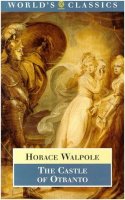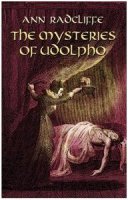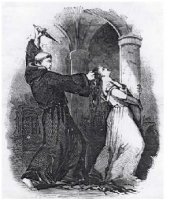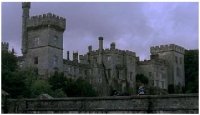Phantoms, fainting heroines, and evil Italian villains: The Gothic novel!
What do Frankenstein, Dracula, Jane Eyre and Rebecca have in common? They’re all descendants of the 18th and 19th century Gothic novels.
The Gothic novel was immensely popular in the late 1700s and early 1800s. It blended romance and horror and were widely read in their day – particularly among women, who (like today) are the majority of the novel-reading public. And, like today, those female-skewered demographics often meant that the genre was looked down upon and criticized by prominent male intellectuals of the day.
Although, in her Gothic parody, Northanger Abbey, Jane Austen does a wonderful job of poking fun at a male character who claims never to read such novels, then rattles off entire plot lines and key scenes of the same books.
The birth of the Gothic novel is generally dated at 1764, with the publishing of Horace Walpole’s The Castle of Otranto. I just read this novel filled with fainting heroines, a spooky castle, secret tunnels, an evil Italian villain, and a curse on the family.
 I was surprised to learn that its publication was an elaborate hoax. Walpole originally published it – fictitiously – as the translation of a recently-discovered novel written during the Crusades (Otranto, a town in Puglia along the Adriatic coast, was a popular port for ships leaving Europe with soldiers on their way to fight in the Holy Lands).
I was surprised to learn that its publication was an elaborate hoax. Walpole originally published it – fictitiously – as the translation of a recently-discovered novel written during the Crusades (Otranto, a town in Puglia along the Adriatic coast, was a popular port for ships leaving Europe with soldiers on their way to fight in the Holy Lands).
Apparently, when he wrote it, Walpole didn’t even know Otranto had a castle, he just liked the exotic sound of the name. When the novel met with rave reviews and praise, Walpole admitted to the hoax and came forward as the author in the novel’s second edition.
But the Stephen King or Dan Brown of the era was undoubtedly the London-born Bath author Ann Radcliffe (1764 -1823). Her 1794 novel The Mysteries of Udolpho – the first she penned under her name – fetched the unheard of sum of 500 pounds, while The Italian, published three years later, did even better, with an unprecedented 700 pounds.
I read and enjoyed The Mysteries of Udolpho. Admittedly, the story is a bit overwrought, with our young, orphaned heroine Emily St. Aubert swept away to the Italian haunted castle of Montoni, the evil Gothic villain who marries Emily’s aunt to steal her money. Montoni locks his new wife in his castle’s tower, slowly starving her and denying her medical attention until she agrees to hand over her fortune.
Montoni and his swarthy band of Italian thieves – for the villains in these novels are always Italian, sexually-threatening, and swarthy – are a threatening presence in the castle. While imprisoned in the castle, Emily faints dozens of times at the odd sounds coming from the secret passageways and at what lies beneath the famous “black shroud.”
 Radcliffe writes in some detail about landscapes and countries she’d never visited, and so there are some amusing passages about the mountains surrounding (extremely flat) Milan and all the lemon and orange trees in (decidedly untropical) Turin. She has 16th century Venice filled with cafes, when coffee was only introduced into Europe by the Ottomans in the mid-17th century.
Radcliffe writes in some detail about landscapes and countries she’d never visited, and so there are some amusing passages about the mountains surrounding (extremely flat) Milan and all the lemon and orange trees in (decidedly untropical) Turin. She has 16th century Venice filled with cafes, when coffee was only introduced into Europe by the Ottomans in the mid-17th century.
Nevertheless, despite errors and anachronisms, it’s still an enjoyable read. As I read this, I summed up the story to my eight-year-old son and he was on the edge of his seat, begging me each day to “read faster”. Not all that easy with six hundred plus pages written in tiny font…
Edgar Allen Poe was a great Radcliffe fan, and so was Jane Austen, whose novel Northanger Abbey was well recognized at the time as a spoof of The Mysteries of Udolpho.
Catherine Moreland, the seventeen-year-old protagonist of Austen’s Northanger Abbey devours Gothic novels, which fuel her overactive imagination. When she is invited to Northanger Abbey, the home of her new friends the Tilneys, Catherine begins to suspect that its owner, General Tilney, is a true Gothic villain. (Our heroine should have been tipped off by the simple fact that the suspect-in-question isn’t Italian.)
Catherine soon learns that the terrifying novels she loves do not reflect real life, but not before her foolishness jeopardizes a romance developing with Henry Tilney.
So, readers, my advice would be to snuggle up by a warm fire in your drafty, haunted Italian castle, ignore the howls and clanging coming from your secret, underground passageways, and enjoy reading your 18th century Gothic novel.
Just be sure to keep your smelling salts close at hand, particularly for female readers. Passing out at key moments of terror appears to be our specialty…



Sounds like a creepy and euphemistic version of 50 Shades? All those implications and swarthy foreigners. I wonder how many of them were tongue-in-cheek. It could even be fun to write one! Xcat
Good points, Catherine. Well, I suppose there was that element, too. I haven’t read “The Monk” yet, but it was supposed to be very transgressive for the time. So I guess there was something to the criticism of the era, saying that young, impressionable girls shouldn’t be reading such books…
Great post, Kimberly, but I have to admit…I do feel a little faint at all this talk of swarthy Italians. I would love me a castle full of secret passageways, however.
Ha for the swarthy Italians, Chantel. BTW, Radcliffe is often called the mother of romance novels, since these Gothic novels always had a strong element of romance in them. I love the idea of a castle full of secret passageways, too, but the ghosts and evil spirits I could do without… : )
One day I should be brave and read these stories, then…
Hi, Julia! By today’s standards – and even by slightly later standards like Bram Stoker or Edgar Allen Poe – I don’t think these would be too scary. But definitely worth reading!!